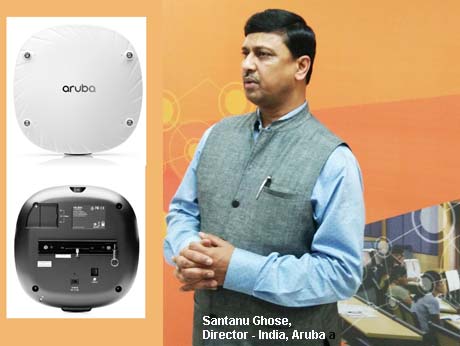
Aruba seminar at IIIT-Bangalore, unveils first WiFi6 access devices
From Anand Parthasarathy
Bangalore, May 2 2019: WiFi -- the wireless solution that links users and devices at home, in the office and in lakhs of public "hotspots" -- is 20 years old this year and has gone through 5 technology upgrades which have kicked up data speeds by a factor of 50 to nearly 1 gigabit or 1000 megabits per second.
2019 will see the 6th iteration of WiFi and a nomenclature change for the better. Instead of calling the versions 802.11 b, g, n, ac, based on the original number that relevant standard bore, the new and 6th version will be known simply as WiFi 6, promising an almost 4-5 times improvement in data speeds and transfer. By year end, customers for a host of WiFi-driven devices from routers to smart TVs to smart home automation to voice-controlled home appliances will be offered new editions that are WiFi 6-compatible. But is the service industry geared to offer the zippier speeds of WiFi 6 which will easily exceed 1 GBPS and probably offer a peak speed of 5 GBPS?
Last week at a workshop hosted by the International Institute of Information Technology in Bangalore ( IIIT-B), Aruba, a company in the Hewlett Packard group specialized in networking solutions, briefed engineers from dozens of OEMs, system integrators and retail product makers and service providers, on what needs to be done to ensure that Indian enterprises are ready to roll out devices and solutions that will help consumers experience the dizzying speeds of WiFi 6, along with the rest of the world.
Led by Santanu Ghose, Director -- India at Aruba and Shubha Chandrasekhar, Marketing Manager for Aruba at HP Enterprise, the company unveiled some of the global networking industry's first WiFi 6-ready devices: These include Series 530 and 550 Access Points which eliminate the need for IoT gateways and result in a significant saving in network management overheads. This could be an important factor as IoT devices are exploding at around 14 million a day worldwide.
------------------------------------------------------------------------------------
This story was also carried in the portal, Profit from IoT of
the EFY ( Electronics for You) group. Read here
-------------------------------------------------------------------------------------
"What we are going to experience is the Perfect Data Storm of Mobile, IoT and the Cloud", Ghose says. The company has set up the WiFi infrastructure for some of the largest and densest networks: the Chatrapati Shivaji International Airport Mumbai, the nationwide GST network of the Government of India, India's biggest public WiFi, the Aaple Sarkar network of the Maharashtra government in Mumbai, the Bhopal Smart City, SBI's 3-lakh device -strong data network, the Kumbh Mela...
WiFi 6 will inevitably impact all such projects -- even as the aam aadmi demands a better, faster way to use Wifi to transform today's homes to tomorrow's smart homes.Ghose also points to an interesting development: mobile service providers, increasingly partnering WiFi providers in a win-win situation. How does this work? Say, I am a 4G ( soon 5G) customer of Airtel, Jio or Vodafone. When I am in a public or office area where fast WiFi is already working, an arrangement between the phone company and the WiFi network owner will recognize my mobile subscription and seamlessly shift from data network from cellular LTE to WiFi for better speed and reliability. This is increasingly how cellular 5G and WiFi 6 will work together in the near future, suggests Aruba.
Time to say hello to the 5G-WiFi6 sangam! Service providers and consumer OEMs have no time to waste, if they are to ride this new telecom wave.